
Review GSM phone Siemens CFX65
Siemens
CFX65. Live pictures
Siemens
CFX65. Official photos
Siemens
CFX65. Photos from the presentation
Standard kit:
- Handset
- Battery
- Charger
- Manual

Having released CF 62 Siemens has prepared its elder variant
equipped with a camera CFX65 (Venus Lite). The phone has the
dimensions of 97x48x23 mm and weights 88 grams. The device is
impossible to call a thin or a thick one, it is the golden mean. The
first thing that prepossesses is its qualitative plastic and that's
impossible to say it is a middle class product just by holding the
device in a hand, it certainly looks more expensive. Unfortunately,
the practice proved it's steady when speaking about abrasion but
that doesn't concern falling. The upper layer is cut off easily and
if that cut appeared then a chain reaction is possible in the future
so the phone peels off.
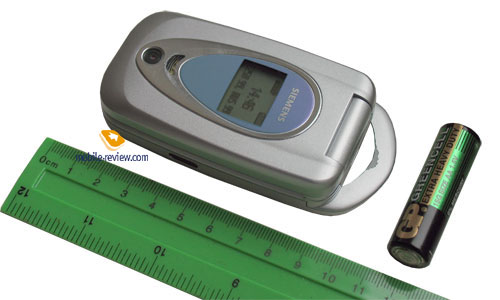
The model is available in two color solutions - Chameleon, Blue
Pearl. As for the first one depending on the lightning and light
angle some elements (external side, a keypad inside) shimmer with
various tints. That's an interesting solution that is rather seldom
still.

A loop-antenna is used in the phone similar to CF62 and it looks
like a small eye in an upper part of the device. A strap is
comfortable to put through this eye and thus carry the device but
you shouldn't fix there any metallic clamps that may influence the
work of the device negatively.

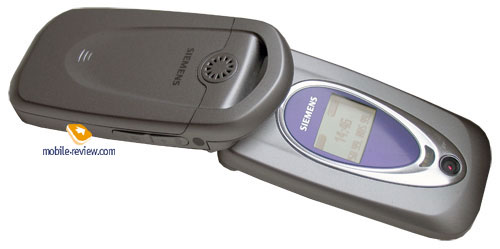
An external screen is integrated into an oval distinguished with
an enameled edging and another colour. It is monochrome with the
resolution of 96x64 pixels. The external screen shows digital clock,
icons of missed events, calls and numbers or names of callers. The
backlighting colour is pale blue. It may be activated by pressing a
coupled button on the left-side surface in the standby mode.
Pressing the button for a long time activates a flash in the lamp
mode that is also on the front surface. The backlighting is bright
and the device is good to use as a lamp. This is the first time a
similar function appeared in a device by Samsung and now European
manufacturers take it over.

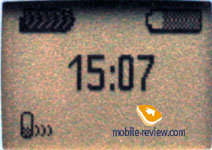 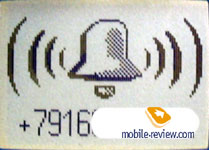
There is an IrDA gap on the right side. Here it is fully
functional and the software installed allows sending not only one
file at the same time but several or even all the files. That is
very convenient and many models by other manufacturers can't boast
with this function.
There is a standard interface connector on the bottom end and it
is compatible with other models of the product line. A loudspeaker
gap is seen on the back surface. This loudspeaker is responsible for
reproducing sounds.
The device may be opened with one hand though it takes time to
get used to (not very easy but not too hard also). An internal 65K
STN screen has the resolution of 128x160 pixels. Subjectively, the
quality is inferior to the one in Siemens models (CX65,
C65,
S65)
but is comparable with Motorola
v220. The screen is quite acceptable for its class though loses
to TFT screens by Samsung. It shows up to 6 text lines and two
service ones. The picture is seen in the sun but it may fade in a
bright summer sun.
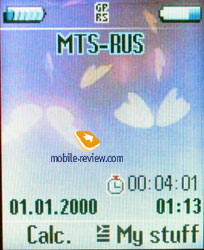
The keypad is of plastic and pleasant to work with. A navi button
is 4D with an OK button integrated. The backlighting is blue but the
characters are seen not in all the conditions.

The back cover (that has no backlash) hides a Li-Ion 600 mAh
battery. According to the manufacturer it is capable of working for
up to 6 hours in the talk mode and up to 200 hours in the standby
mode. In Moscow the device worked for about 2.5 days in case of 40
minutes of talks and up to 10 minutes of using other functions. Full
recharging takes about 1.5 hours.
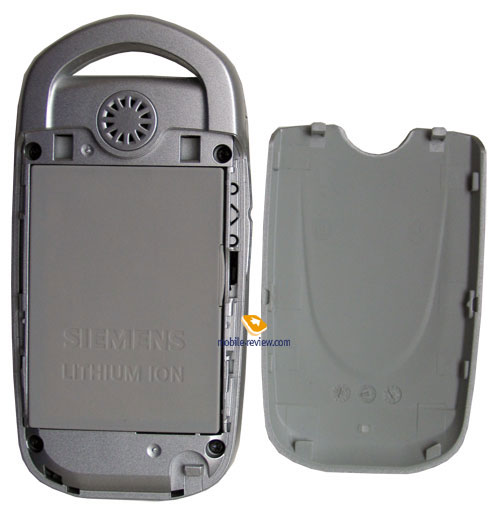
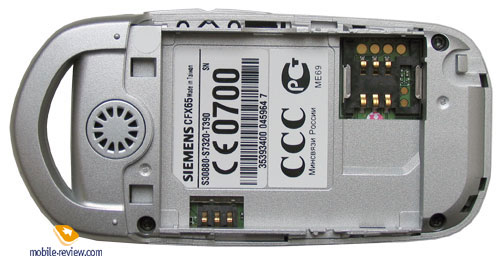
Menu
At first sight of the menu you'll see much in common with Siemens
CX65 and the devices seem to copy each other. But in difference to
CX65 the clamshell has less internal memory - 3.7 MB (against 11 MB
in CX65). And that puts limitations on the total number of entries
in a separate function.

The main menu is represented with 9 icons in three rows with
three icons in each. The icons are designed in the same style as in
other modern phones by Siemens and they are more for youth. Many
users notice that the icons are not very expressive and look not
very vivid if compared with the phones by Korean manufacturers. I'll
stress that the icons are simple and look like drawn by a child and
that is the reason of such a reaction.
Submenus are lists and here everything is traditional. Moving
along the menu is possible using digital series. In general the
navigational possibilities are quite close to the maximum that can't
but gladden.
The localization is comparable with other phones by Siemens,
there are very many abbreviations not clear for the first time and
that leads to some confusion. Traditionally the translation of some
items remains the same that is also bad and doesn't make navigation
along the menu easier. For those ones acquainted with the phones by
Siemens that won't make any troubles but those who buy the phone for
the first time will have to get used to it for or to use the menu in
English.
Text input rouses no problems; the device has T9 dictionaries and
quick switching between the languages when typing.
The interface of this model got its logical development, icons
for many of the events appeared, and another organization that makes
user's life easier. Similar to the phones by Alcatel an event log
appeared, all the missed calls, reminders and alarms, messages are
stored there. In some kind it is more logical and convenient for a
user. Thus a register that appears with the first event is assigned
to the left soft key. On pressing the left soft key you get into the
list from which you may view any event, all of them are signed
according to the type (a call, an alarm clock, a message) and have
the phone number, the beginning of the message, an alarm time and
etc. in the first line.
To compare a united event log with a usual organization of missed
calls I will remind the way it is done in Nokia's phones (it is
possible to mention the other manufacturers but Siemens competes
with Nokia and it is more logical to compare these two companies).
So, missed calls have the highest priority, you'll see notification
about them on the screen. Having viewed information on calls and
switched to the standby mode you'll see information about received
messages. Looking through them you will see information about missed
notifications and so on. So, as you can see the organization of a
united list looks more well-taken.
Phone book. Internal memory is shared
dynamically between all the applications, but at the same time there
is a limitation of 250 names for the phone book. You can keep Name
and Surname, Home, Office, Mobile phone numbers, two Fax numbers,
two e-mail addresses, a link, Company name, its address (City,
Street, Post code, Country) for a name. In addition to these fields
there is an opportunity to enter birthday and set a reminder for it.
And there is a possibility to assign any graphical file to a name,
whether it is a photo or just a picture.
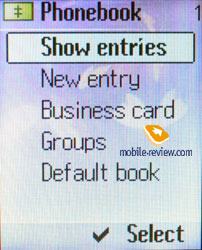 
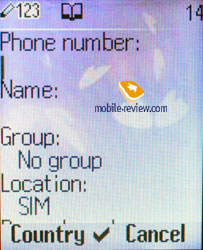 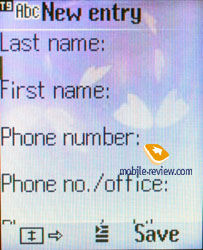
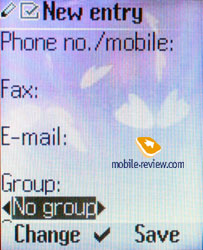 

In the general list all the icons for all the filled in fields
for a name are displayed (in one or two lines). The photo is not
shown and to view it you should view the whole information on the
name.
There are 9 users' groups in the phone, there is a possibility to
rename each of them and assign a photo. A special melody may be
assigned to a group, but it is useless to look for this setting in
the address book, it is referred to call settings. It is not quite
logical but you can get used to it.
During incoming calls the picture is shown not on the whole
screen but it is rather big. Another minus is that the number is
displayed only during first seconds and if there is a photo it is
replaced with it then. Also the type of the number is not shown,
only the name. In general even for outgoing call you click on the
user's name, choose a necessary number from the list and call. The
icon is the same for all the numbers, no differences. Hence, a
question rises - what is dividing into groups necessary for in
general, excluding synchronization with PC? There is no possibility
to reassign fields that means that if a user has two mobile phones
then you'll have to keep the second one as Home or Office phone
number. It doesn't make any discomfort but confusion may appear
especially if you have many acquaintances with several mobile
phones.
Messages. It is possible to save up to 100
messages in internal memory, which is shared dynamically. General
list shows messages in internal memory and on a SIM-card, the last
ones are marked with a corresponding icon. You can create templates
and folders. There is a support for MMS and the settings are rather
simple, you'll make them in 3-4 minutes (for Moscow and Saint
Petersburg they are preset).
 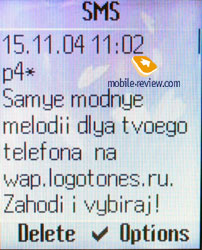
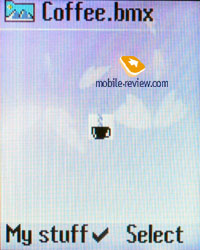 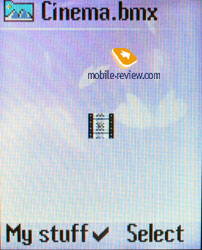
 
 
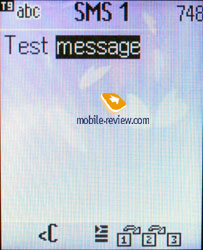 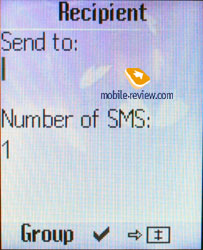
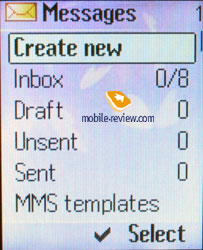 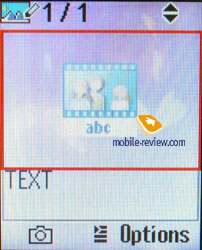
The interface for entering messages is really nice, it is
possible to shift between separate pages quickly and there is no
need in calling contextual menu. Notifications about the size of the
message appearing while sending it became a pleasant surprise. Also
you have to set the time period for delivery to the addressee (from
one hour to eternity). If your operator charges for the size of the
message the function is really important. Getting MMS is possible in
manual or automatic mode and the last one is possible only in your
network but not in a roaming. It is interesting that in automatic
mode the phone honestly warns that sometimes it can be expensive.
There is an opportunity to create own templates. The realization
of work with messages is on the same level as the best models have.
A pleasant additional feature is a possibility to choose a font-size
while reading messages (standard, large and small). You are free in
your choice.
Call lists. There is a call log of 100 outgoing,
incoming and missed calls with date, time and duration. This is the
first time that lists in a usual phone but not a smartphone are so
long. That gives a possibility to keep the calls from the same
number received one after another separately and not to sum them
up.
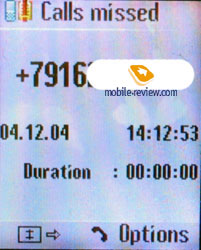 
The type of the number from the phone book is not specified but
the number is shown in an evident view.
Parameters. A great number of various settings
is kept here, let's consider them in order.
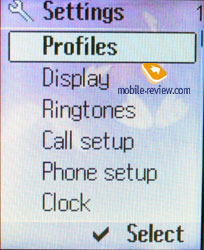 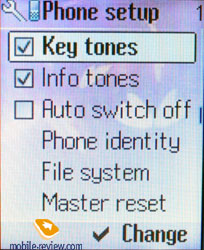
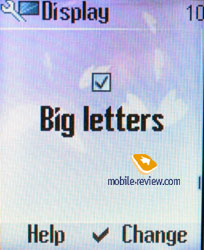 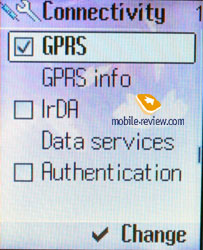
Automatic turn off according to a timer allows turning the device
off following a schedule.
Profiles. Traditionally it is possible to set the behaviour of
the phone in different conditions (vibrating alert, call melodies
and etc). A possibility to copy all the settings of one of the
profiles into another, it is a pleasant trifle when you need to
change only one or two parameters of an already adjusted profile.
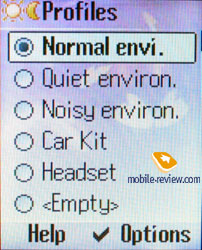 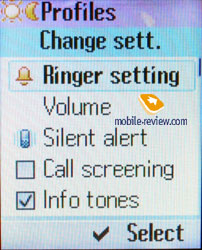
Melodies. A possibility to choose call and other melodies.
Display. From here you also can set the wallpaper, animations
that appear when turning the phone on and off, font size.
Organizer. The calendar itself is organized
traditionally; there is a month view, a possibility to switch to the
week view with dividing on hours or to the day schedule. Separate
menu items allow viewing all the events of a certain type, for
example, meetings, notes and memos. A total number of storable
events is 100.
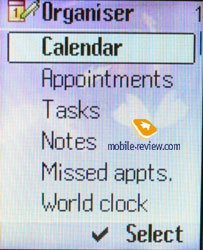 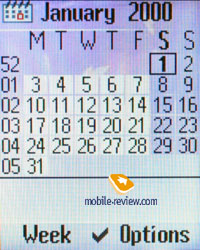
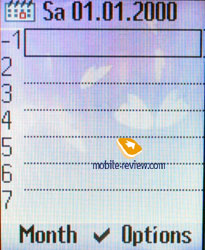 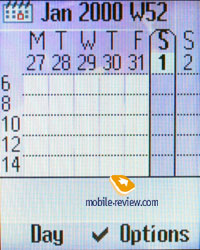
 
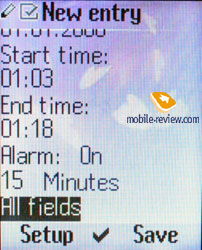 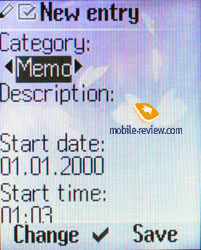
Events may be once and recurrent, there is a possibility to set
the view of all the fields while entering an event or only some of
them. A voice mark may also serve as a reminder.
There is a separate to-do list, it is possible to set not only
the date but a notification also. Evaluating in 5-mark scale is
possible for a task.
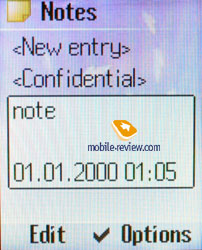
Notes are ideal to enter a small text message. A note can be open
to general use or confidential, and then you'll have to enter a
phone code.
You can see world time in the biggest cities from the organizer
menu, it is very convenient. A dictaphone is also here and the
number and duration of the records are limited only by free memory.
By default it is about 70 minutes. Unfortunately, the dictaphone
doesn't work during a conversation that became traditional for
Siemens devices. Dictaphone records may be turned into call
melodies.
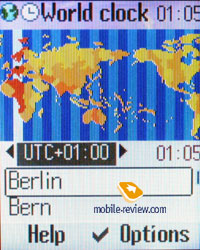
My Stuff. In this folder you keep all the
programs and files, everything is structured and clear. There are
two ways of displaying the folders - as a list and small icons. For
the photos the second way is more preferable. Unfortunately, all the
standard folders look the same way if displayed as icons, that makes
some confusion and one has to look at notes on the top.
 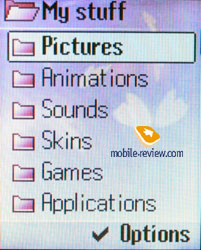
 
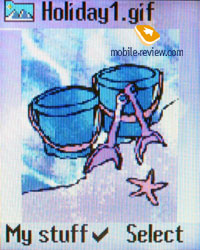 

Extras. In this part of the menu you can find an
alarm clock, it may be set for certain days of the week. The alarm
clock is one.
 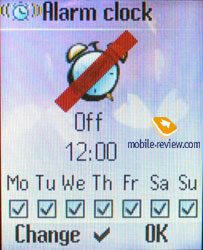
Calculator - a function to remember intermediate results (memory
function) appeared, the calculator is convenient.
 
Unit converter, everything is simple and functional.

A stopwatch allows creating up to two points of reference and
save them to a file. Countdown timer is also present.
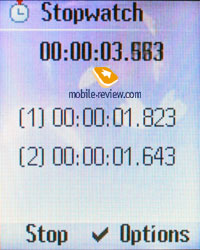 
File System. As different to previous models
only memory formatting is possible here but not viewing it or
editing.

Fun&Surf. Here is wap-browser version 2.0,
the settings for it are a bit higher than average, it is easy to add
new bookmarks, a large screen allows to navigate different resources
easy.
There is one preinstalled game. That is Marble Crossing where you
need to move a ball in a labyrinth.
 
Camera. A VGA-camera is integrated into the
phone and the manufacturer decided to refuse indicating standard
picture resolutions and only names are given here - Premium (640 x
480), high, medium, Wallpaper. There is a possibility to change a
default file name and thus it may contain a current date and time
(these are templates). White balance may be set automatically or
manually (street, indoors).

12
pictures in one ZIP-archive, 350 KB>>>
The screen serves as a viewfinder and the picture is almost not
blurred when moving fast. Brightness may be adjusted with one touch
and the same for using a digital zoom function. The device doesn't
record video.
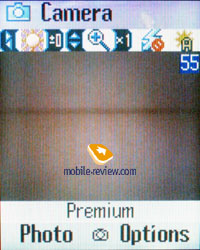 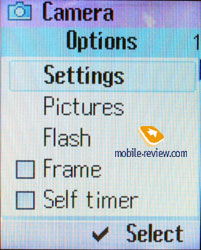
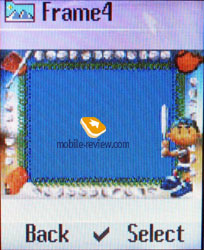 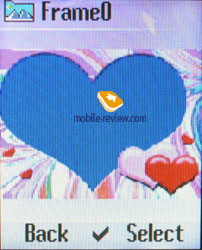
 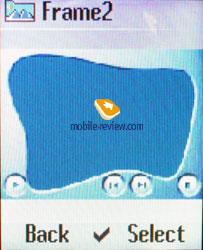
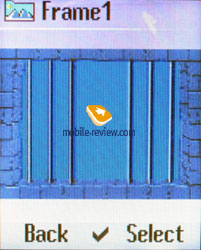 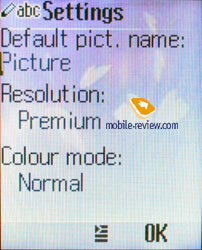
The quality of the picture on the screen and on a PC still leaves
much to desire, it is degraded and illegible. We tested the quality
on several examples and the same things happened every time. The
camera has an evident defect and it's not known whether it will be
improved in the next deliveries.
Impressions
The device has no problems in the quality of connection and the
volume of the loudspeaker is enough almost in all the situations.
The polyphony is 40-tones and it sounds like with metallic notes, it
is provided in a better quality in other 65-series phones by
Siemens. The power of a vibrating alert is average and vibrations
are short that will not suit many users, such call is easy to miss.
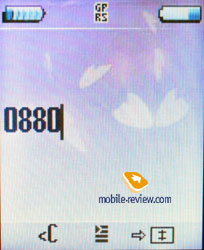 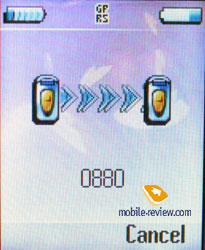
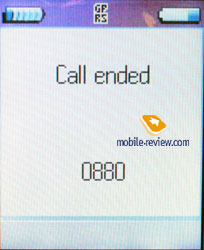 
Taking into consideration the price of the device (230-240 USD)
we should say it is overpriced greatly. Now there is Motorola
v300 with similar characteristics (plus a better screen) and a
price of about 175 USD, a functionally better Motorola
v500 (bluetooth is present and the price is about 200 USD) in
the market. The price of about 160-170 USD may be considered
appropriate for Siemens CFX65 but not more. And that is especially
considering its STN-screen, not qualitative camera and a very slow
Java. That seems it's better to put off buying the model until the
price falls and that will happen very quickly. CF62
was rather interesting in its segment and the same may happen to
CFX65 after the fall of the price. Now Siemens started skimming the
cream again, the price of new models (except for the low-end ones)
is extremely high in the first weeks of sales.
P. S. As for me, CFX65
is not as bad for its class but it lacks a raisin, its unique face.
The device looks rather weak against a background of other
clamshells and that's good the company is not known in this segment
much. The priority of Korean manufacturers is higher when buying a
device of this form-factor. The price of CFX65 will get 50 USD less
with the appearance of Motorola
v535 in the market. And that will happen soon.
Sample
melodies (mp3, 360 KB)
Links on the topic:
We are grateful to Alt
Telecom for the provided phone |



